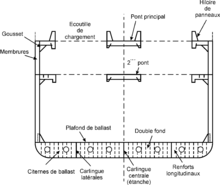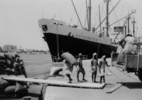General cargo ship

A cargo ship or general cargo vessel is a vessel in which all types of cargo to be transported. General cargo are loads that do not have standard dimensions, such as B. is the case with containers .
properties
General cargo ships ( English general cargo ships used to have) also has facilities for refrigerated cargo and Süßöltanks . Today, refrigerated containers or refrigerated container ships as well as tank containers for liquid or gaseous products dominate.
General cargo is, for example:
- Boxes
- bags
- Bale
- Cardboard boxes
- Barrels
- Crates ( packaging made of wood or plastic in the form of a spatial frame construction)
- unpackaged goods [plant components, machines and vehicles]
- Heavy cargo (particularly heavy and large items of cargo, some of which were also carried as deck cargo ).
A general cargo ship (in the sea) has in the cargo holds tween decks , to make optimum use of the available space. A general cargo ship normally has its own loading gear in all holds so that it can unload its cargo even in smaller ports that do not have their own cranes .
The creation of a stowage plan (loading plan ) is essential on a general cargo ship . Depending on the size of the ship, the creation of the stowage plan is a demanding task due to the shipping area and the number of unloading and loading ports to be approached as well as different loads. The master , who is advised by a supercargo if necessary, is responsible for the cargo . On larger general cargo ships in liner service (express freight service), the captain delegates loading operations to his officers, with an experienced second officer (loading officer) usually taking on this role. Time and deadline pressures play an important role; therefore the cargo officer is supported by a third officer and, if available, by an officer assistant (sailor-OA), nautical officer assistant. When loading a general cargo ship, the loading officer has to consider a number of things:
- the individual batches must be stowed in the ship in such a way that they can easily be unloaded in the desired sequence in the ports of destination.
- the cargo must be distributed in the ship in such a way that the stability and safety of the ship is guaranteed throughout the voyage.
- The individual loads should be accommodated as optimally as possible, that is, the location in the ship must be prepared where necessary (Garnier) ; valuable cargo in lock rooms etc.
- The cargo must be stowed in a seaworthy manner and lashed accordingly where necessary.
To clarify, here is the excerpt from the ship's diary of MS Tannstein , 42nd voyage home, based on NY 09.01.66 …… “The cargo was well garnished by professional stevedores under the supervision of the ship's management and stowed according to seaman's custom. The cargo was lashed, lashed and braced. The Mc Gregor hatches were set down and wedged. " -
In the general cargo liner service, the same ports are called regularly; From the shore, the respective freight departments of the shipping company in the home port, while liner brokers and freight agents (waterclerk) abroad take care of the rapid processing of the ship, whereby one can assume long-term contacts. This group also includes the stevedoring with their army of skilled port workers who load a ship under the guidance of experienced foremen (Viez). It is the task and duty of a cargo officer to maintain a good and trusting cooperation with this group of people.
The loading operation on a typical general cargo ship can be clearly seen in the adjacent photo from 1959. In addition to the tank , which is being hoisted on board, you can see tree trunks / logs on both sides of the fore ship as a deck load. On the deck are wood hatch cover , hatch beams , an amount of dunnage to Seefest making the charge, cordage and wires. You can see open hatches and extensive loading gear that is operated by dock workers .
history
For decades, general cargo ships have handled almost all of the cargo transport involved in world trade .
An example of the conventional design of general cargo ships were those of the Tannstein class . Amidships were the superstructures with the navigation bridge , the saloon and the living rooms for the captain , officers, passengers and crew. In front, under the forecastle , were the cable arm with lamp room and the nautical workshop. Aft was the steering gear and in a deckhouse the laundry and the workshop of the on-board electrician. - Ships with a raised stern, midships and aft superstructures are also called “three-island ships”.
Depending on the client's requirements and wishes, a conventional general cargo ship could also look different. The ships of the Rendsburg Nobiskrug shipyard with the bridge structure amidships and the engine, the crew quarters with kitchen and provisions rooms aft are mentioned here as an example ; see MS bleaching .
In the past there were not only general cargo ships in the liner service. Often only general cargo was transported on departure and bulk cargo on the journey home in a sub-room or a hatch .
General cargo ships of the old design had the engine room aft and living quarters amidships. The latter was advantageous for people on board: calm and almost vibration-free in good weather, less movement of the ship in a storm.
The most famous general cargo ships of the old design include the Liberty Freighters , a unit ship used by the Americans during the Second World War . General cargo ships transported everything that could be loaded into the holds with cranes.
present
Modern general cargo ships only have one structure (usually at the stern ). The navigating bridge, the living and common rooms and the engine room are combined here.
As more and more container ships were built, these displaced general cargo ships in many places. The latter are only required for special cargoes that do not fit in containers or for shipping areas in which container ships are not used. Modern general cargo ships are often built as semi-container ships (suitable for both general cargo and containers).
In the field of sea freight, container traffic has established itself for almost all cargoes in question. However, a small niche has remained, namely the area of project and heavy lift transport (see also the article on heavy lift carriers ). This means all goods that are too big, too bulky or too complicated to be loaded onto container ships, e.g. B. machines, cranes, components, aircraft technology, tanks, turbines , complete power plants and prefabricated systems and factory parts. In the case of very heavy, very unbalanced and / or very sensitive parts, the correct stowage and securing on board can be very complex.
- General cargo: boxes - bagged goods - bales - cardboard boxes on pallets - heavy goods - special goods - reinforcing steel and wire rolls - car tires - barrels
Bayernstein :
loading boxesRothenstein :
Loading of bagged goodsHolstenstein :
cardboard boxes on palletsSaarland :
Heavy cargo as deck loadSpeyer :
Loading of reinforcing steel and wire rollsVogelsberg :
unloading barrels
See also
literature
- Harald Focke , Eberhard Nölke: The captain and his officers, ship command on general cargo carriers. Oceanum Verlag, Wiefelstede 2016, ISBN 978-3-86927-407-2 .











